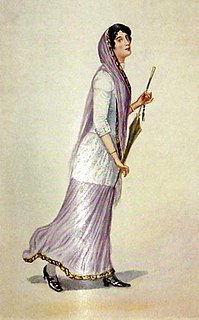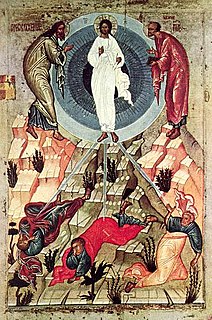
Meher Baba was an Indian spiritual master who said he was the Avatar, or God in human form, of the age. A major spiritual figure of the 20th century, he had a following of hundreds of thousands of people, mostly in India, but with a significant number in the United States, Europe and Australia.

Zoroastrianism or Mazdayasna is an Iranian religion and one of the world's oldest organized faiths, based on the teachings of the Iranian-speaking prophet Zoroaster. It has a dualistic cosmology of good and evil within the framework of a monotheistic ontology and an eschatology which predicts the ultimate conquest of evil by good. Zoroastrianism exalts an uncreated and benevolent deity of wisdom known as Ahura Mazda as its supreme being. Historically, the unique features of Zoroastrianism, such as its monotheism, messianism, belief in free will and judgement after death, conception of heaven, hell, angels, and demons, among other concepts, may have influenced other religious and philosophical systems, including the Abrahamic religions and Gnosticism, Northern Buddhism, and Greek philosophy.

Parsis or Parsees are an ethnoreligious group of the Indian subcontinent adhering to Zoroastrianism. They are descended from Persians who migrated to Medieval India during and after the Arab conquest of Iran in order to escape persecution by Muslims and preserve their Zoroastrian identity. The Parsi people comprise the oldest of the Indian subcontinent's two Zoroastrian communities vis-à-vis the Iranis, whose ancestors migrated to British-ruled India from Qajar-era Iran. According to a 16th-century Parsi epic, Qissa-i Sanjan, Zoroastrian Persians continued to migrate to the Indian subcontinent from Greater Iran in between the 8th and 10th centuries, and ultimately settled in present-day Gujarat after being granted refuge by a local Hindu king.

A tariqa is a school or order of Sufism, or specifically a concept for the mystical teaching and spiritual practices of such an order with the aim of seeking haqiqa, which translates as "ultimate truth".

Christian mysticism refers to mystical practices and theory within Christianity. Mysticism is not so much a doctrine as a method of thought. It has often been connected to mystical theology, especially in the Catholic Church and Eastern Orthodoxy and Oriental Orthodoxy.

Sooni Taraporevala is an Indian screenwriter, photographer and filmmaker who is the screenwriter of Mississippi Masala, The Namesake and Oscar-nominated Salaam Bombay! (1988), all directed by Mira Nair. She also adapted Rohinton Mistry's novel Such A Long Journey(2000) wrote the films Dr. Babasaheb Ambedkar her directorial debut Little Zizou as well as her latest film Yeh Ballet (2020) A Netflix Original that she wrote and directed.

In Zoroastrianism, the Amesha Spenta are a class of seven divine entities emanating from Ahura Mazda, the highest divinity of the religion. Later Middle Persian variations of the term include the contraction 'Ameshaspand' as well as the specifically Zoroastrian 'Mahraspand' and 'Amahraspand'.

Bhikaiji Rustom Cama or simply as, Madam Cama, was one of the prominent figures in the Indian independence movement.
Dovber Schneuri was the second Rebbe of the Chabad Lubavitch Chasidic movement. Rabbi Dovber was the first Chabad rebbe to live in the town of Lyubavichi, the town for which this Hasidic dynasty is named. He is also known as the Mitteler Rebbe, being the second of the first three generations of Chabad leaders.

The Ateshgah of Baku, often called the "Fire Temple of Baku", is a castle-like religious temple in Surakhany town, a suburb in Baku, Azerbaijan.

Maneckji Limji Hataria (1813–1890) was an Indian scholar and civil rights activist of Parsi Zoroastrian descent, who took up the cause of the Zoroastrians of Iran.
The Desatir or Dasātīr, also known as Dasatir-i-Asmani, is a Zoroastrian mystic text written in an invented language. Although purporting to be of ancient origin, it is now generally regarded as a literary forgery, most probably authored in the 16th or 17th century by Azar Kayvan, the leader of the Zoroastrian Illuminationist sect. Its Neoplatonic ideas have been strongly influenced by the 12th-century philosopher Suhravardi, and have only a tenuous connection to mainstream Zoroastrianism.

The kushti also known as kosti, kusti and kustig is the sacred girdle worn by invested Zoroastrians around their waists. Along with the sedreh, the kushti is part of the ritual dress of the Zoroastrians.

The persecution of Zoroastrians has been recorded throughout the history of Zoroastrianism, an Iranian religion. The notably large-scale persecution of Zoroastrians began after the rise of Islam in the 7th century CE; both during and after the conquest of Persia by Arab Muslims, discrimination and harassment against Zoroastrians took place in the form of forced conversions and sparse violence. Muslims who arrived in the region after its annexation by the Rashidun Caliphate are recorded to have destroyed Zoroastrian temples, and Zoroastrians living in areas that had fallen under Muslim control were required to pay a tax known as jizya.

The Navjote ceremony is the ritual through which an individual is inducted into the Zoroastrian religion and begins to wear the sedreh and kushti. The term navjote is used primarily by the Zoroastrians of India, while sedreh pushi is used primarily by the Zoroastrians of Iran.

Jamshedji Sorab Kukadaru was a Zoroastrian priest in Mumbai, India revered by Zoroastrians for a number of miracles he is believed to have performed. He was well known by his contemporaries for his simple lifestyle and asceticism and unflinching adherence to priestly purity rules. Most of his life is said to have been spent in prayer.

Trance is a state of semi-consciousness in which a person is not self-aware and is either altogether unresponsive to external stimuli or is selectively responsive in following the directions of the person who has induced the trance. Trance states may occur involuntarily and unbidden.

Mysticism is popularly known as any kind of ecstasy or altered state of consciousness which is given a religious or spiritual meaning, but may refer to becoming one with God or the Absolute. It also refers to the attainment of insight in ultimate or hidden truths, and to human transformation supported by various practices and experiences.

Kalpataru Day also called Kalpataru Diwas or Kalpataru Utsav is an annual religious festival observed by monks of the Ramakrishna Math monastic order of Hinduism and lay followers of the associated Ramakrishna Mission, as well as the worldwide Vedanta Societies. These organizations follow the teachings of Ramakrishna, the 19th century Indian mystic and figure in the Bengali Renaissance.

Kharshedji Rustomji Cama (1831–1909), often known as K. R. Cama, was an Indian Parsi scholar and reformer from Bombay.